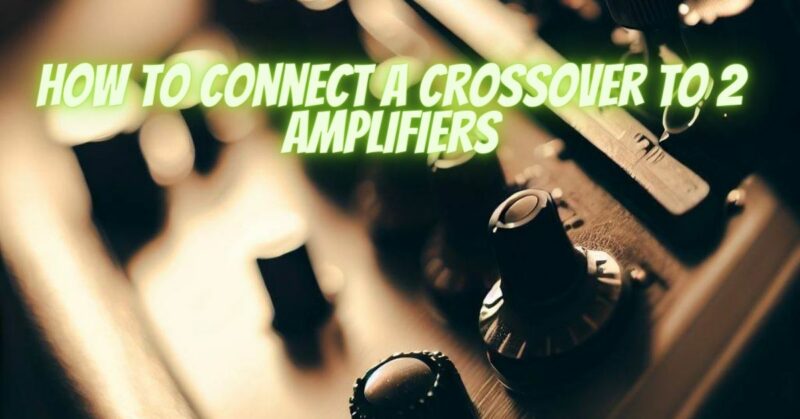Connecting a crossover to two amplifiers is a technique often used in advanced audio setups to achieve bi-amping (using two amplifiers) or tri-amping (using three amplifiers). This configuration allows for greater control and precision in directing specific frequency ranges to different speakers or drivers in your sound system. In this step-by-step guide, we’ll walk you through the process of connecting a crossover to two amplifiers for enhanced sound quality and flexibility.
Tools and Materials You’ll Need:
- Crossover Unit: Choose a crossover unit that suits your system’s needs, such as a 2-way or 3-way crossover, depending on the number of frequency bands and drivers you’re working with.
- Two Amplifiers: High-quality amplifiers with sufficient power for your speakers or drivers.
- Speaker Wires: Quality speaker wires with the appropriate gauge for your setup.
- Interconnect Cables: Cables to connect your source (e.g., a mixer or preamp) to both amplifiers.
- Screwdriver or Wire Strippers: To strip and connect wires.
- Wire Connectors or Soldering Iron: Depending on your preference, you can use connectors or soldering to secure the wire connections.
Step 1: Understand Your Speaker System:
Before proceeding, it’s crucial to have a clear understanding of your speaker system’s configuration, including the number of drivers (woofers, midrange, tweeters), their respective crossover frequencies, and the power requirements of your amplifiers.
Step 2: Identify Crossover Terminals:
Your crossover unit will have input and output terminals for each frequency band (e.g., low-frequency, mid-frequency, high-frequency). These terminals are usually labeled as follows:
- Low-Pass (LP) Input: This is where you’ll connect the incoming audio signal from your source (mixer or preamp).
- Mid-Pass (MP) Input: If applicable, this input receives mid-frequency signals.
- High-Pass (HP) Input: This input receives high-frequency signals.
- Low-Pass (LP) Output: Connect this output to one of your amplifiers.
- Mid-Pass (MP) Output: If applicable, connect this output to the second amplifier.
- High-Pass (HP) Output: Connect this output to your third amplifier (if tri-amping).
Step 3: Strip the Wires:
Using a wire stripper or a pair of wire strippers, carefully remove a small section of insulation from the ends of the speaker wires you’ll be connecting. Ensure you expose enough bare wire for secure connections.
Step 4: Connect the Wires to the Amplifiers:
Connect the appropriate wires to your amplifiers and crossover unit. Here’s how:
- Connect the wires from your source (mixer or preamp) to the LP input on the crossover unit.
- Connect the LP output from the crossover to your first amplifier’s input.
- If you’re bi-amping, connect the MP output to the second amplifier’s input.
- If you’re tri-amping, connect the HP output to your third amplifier’s input.
Step 5: Secure the Connections:
Use wire connectors or soldering to secure the wire connections at both the crossover unit and the amplifier terminals. Ensure all connections are snug and free from any loose wires or exposed conductors.
Step 6: Test the Setup:
Before powering on your amplifiers and speakers, double-check all connections to make sure they are correct and secure. Once verified, you can proceed to test your system to ensure proper sound distribution across the drivers.
Step 7: Power On Your Amplifiers:
Power on your amplifiers one by one, ensuring that each amplifier is receiving the correct frequency range from the crossover unit. Be cautious with volume levels and make adjustments as needed.
Step 8: Fine-Tune the Sound:
With the system running, you can fine-tune your sound by adjusting the crossover settings, amplifier gain, and EQ settings to achieve your desired audio quality and balance.
Congratulations! You’ve successfully connected a crossover to two amplifiers, allowing for bi-amping or tri-amping in your speaker system. This advanced setup can provide greater control over your sound, improved speaker performance, and enhanced audio quality for a more precise and customized listening experience.


